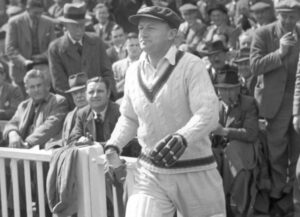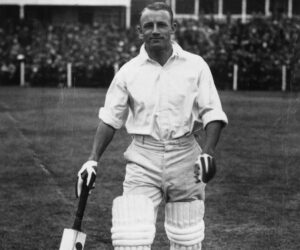Don Bradman was Australia’s greatest sportsman, being the most successful batsman to have ever emerged in the history of cricket — not just in Australia, but in the entire world.
Donald George Bradman was born in Cootamundra, New South Wales, on the 27th of August 1908. He was one of five children; his siblings were one brother, Victor, and three sisters, Islet, Lilian and Elizabeth May. His parents were George Bradman and Emily Bradman (née Whatman).
He grew up in Bowral (NSW) and had an avid interest in cricket. When he was twelve years old, he obtained his first century in a school match (scoring 115 runs, not out, as part of the team’s overall score of 156), and later went on to play for the Bowral cricket team. His natural abilities in the sport were soon recognized and he was invited to play at state level.
In 1927 (at the age of 19), Bradman had his first-class match debut when he played for the New South Wales team, in a match in Adelaide, against South Australia (scoring 118 runs). He went on to join the national team and broke a number of cricketing records.
Bradman was regarded as an eminently fair and honourable player, not only by Australians, but also by many from other cricketing nations. However, his batting ability was so amazing that the English cricket team (led by Douglas Jardine) which toured Australia during 1932-1933 came up with the nasty and most unsportsmanlike tactic of “bodyline bowling”, whereby a ball was bowled in such a manner as to cause a batsman to hit it in an awkward way or else risk bodily injury (these Test matches came to be known as the “Bodyline” series). Bodyline bowling was a tactic widely frowned upon, and during the infamous “Bodyline” series Australian cricket crowds were angry at the English tactics. With regards to one Test match, an Australian player was reported to have said “there are two teams out there and only one of them is playing cricket”.
Despite the problems of the “Bodyline” series, Bradman went on to break more cricketing records. He was later appointed as captain of the Australian cricket team.
In 1930 the song “Our Don Bradman”, sung by Art Leonard (also known as Len Maurice; real name, Leonard Arthur Morris), was released in July 1930 by Regal Records, and became a popular hit amongst Australians.
During the Second World War the famous cricketer served in the Royal Australian Air Force, and then in the Australian Army; however, he was later discharged on medical grounds, due to some health problems which had plagued him for years.
He ended up playing cricket again, before finally retiring in 1948. It is one of the great shames of cricketing history that Bradman did not retire prior to his final match; his Test batting average was over a century, at 101.39, but he was bowled for a duck in his last match and thus his final Test average fell just below the 100 mark, at 99.94.
Don Bradman continued to play a role in the Australian cricketing scene, by taking on an administration role. He was later knighted for his services.
When “the Don” died on the 25th of February 2001, he was hailed as the greatest cricket player that the world had ever seen.
See also:
Don Bradman videos
Our Don Bradman [song, written by Jack O’Hagan, 1930]
“Don Bradman” [song, 1 September 1932]
References and further reading:
Roland Perry, The Don, Sydney (NSW): Pan MacMillan Australia, 1995 [see p. 21 re Bradman’s score as a 12-year-old]
“Don Bradman”, Australian Government
“Donald George Bradman”, Bradman Foundation [archived]
“The Bradman Museum”, Bradman Foundation
“The Ashes. Part 6: Bodyline Series”, Abc of Cricket [archived copy of: http://www.abcofcricket.com/A_Legend_Is_Born/Bodyline/bodyline.htm]
“Sir Donald Bradman at 100”, The Monthly, August 2008
“The Bradman Digital Library”, State Library of South Australia [archived by the National Library of Australia]
“Sir Donald Bradman”, ESPN Cricinfo
“Sir Donald Bradman, 2002: A personal recollection”, [E.W. Swanton] , ESPN Cricinfo
“Obituary, 2002: Don Bradman”, [Wisden Almanack], ESPN Cricinfo
“Don Bradman”, Wikipedia
“Our Don Bradman”, Wikipedia
Updated 5 November 2023



Leave a Reply